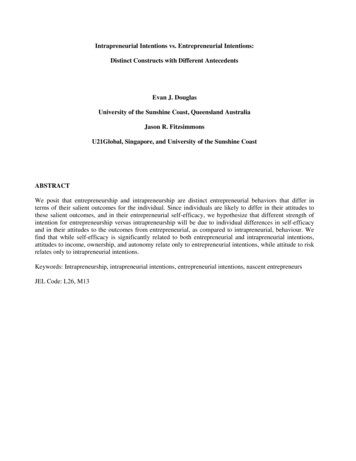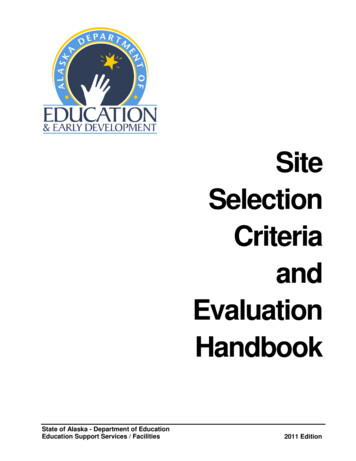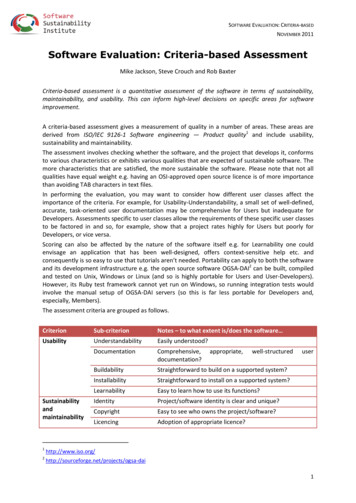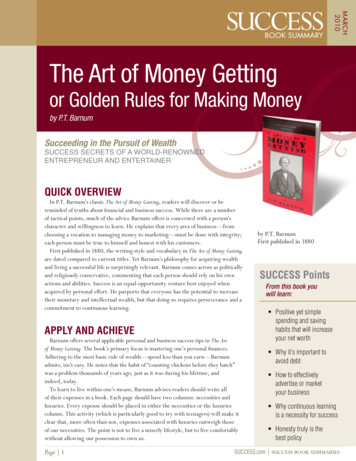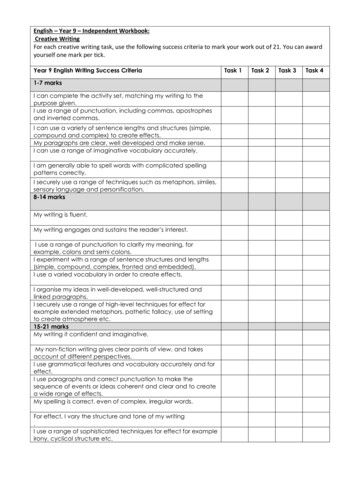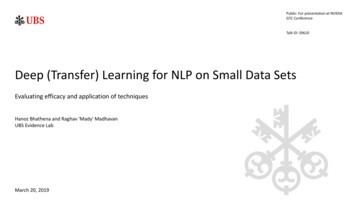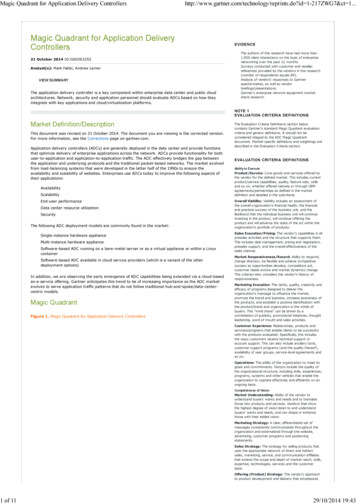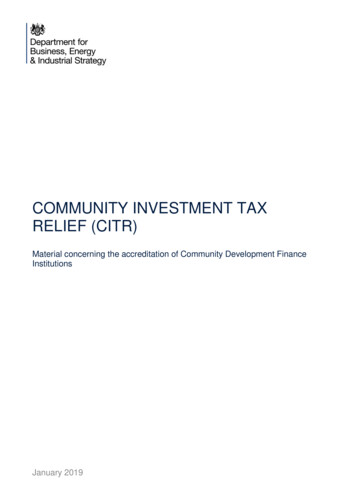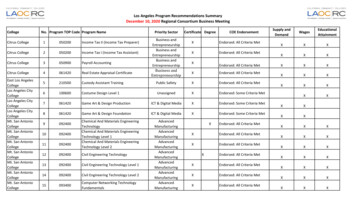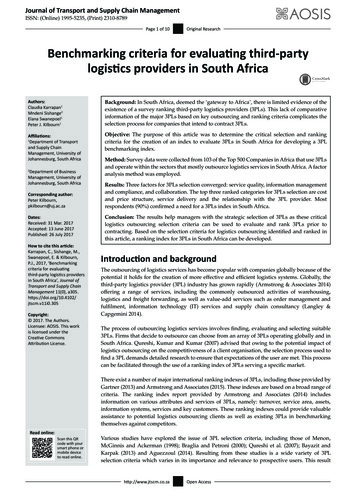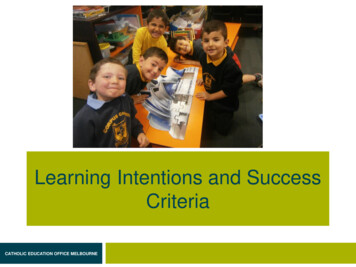
Transcription
Learning Intentions and SuccessCriteriaCATHOLIC EDUCATION OFFICE MELBOURNE
Personalised learning at the intended level of the curriculum attends to studententitlements and optimises outcomes so that learning is deliberate, targeted andrelevant for individual learners. The intended curriculum is developmental enablingmultiple entry points and allows for the local context whilst responding to systemframeworks.Personalised learning at the enacted level is the individual school’s response to theintended curriculum based on deep knowledge of the student, the learningcontinuum (all areas) and professional practice reflecting agreed contemporarypedagogies. It incorporates structures to include student voice in the co-design.Personalised learning at the achieved level is the attainment of each student’slearning intentions based on success criteria and feedback that enables futurelearning and ensures progress over time.CATHOLIC EDUCATION OFFICE MELBOURNE
CATHOLIC EDUCATION OFFICE MELBOURNE
Learning IntentionsTo build our understanding and abilityto develop quality learning intentionsand success criteria for improvedstudent outcomes.CATHOLIC EDUCATION OFFICE MELBOURNE
Hattie and Timperley (2007) describe three questions that guidelearning for students:Where am I going?(Learning intentions)How am I going?(Success Criteria)Where to next?(Feedback)CATHOLIC EDUCATION OFFICE MELBOURNE
Where am I going?(Learning intentions)CATHOLIC EDUCATION OFFICE MELBOURNE
So what are they?Learning intentions are briefstatements that explicitlydescribe what studentsshould know, understandand be able to do as aresult of the learning andteaching.CATHOLIC EDUCATION OFFICE MELBOURNE
Knowing where learners need to go:What we will belearning rather thanwhat we will bedoingCATHOLIC EDUCATION OFFICE MELBOURNE
Knowing where learners need to go The importance of ‘tuning in’ – building on wherelearners are in their learning Setting the scene – why are we learning this Explain the situation Linking to what is known Unfamiliar words and phrases are explainedCATHOLIC EDUCATION OFFICE MELBOURNE
When students know the learning intention. Focus on the purpose of theactivity Know where to focus theirefforts More likely to stay on task Take responsibility for learning.CATHOLIC EDUCATION OFFICE MELBOURNE
Learning Goals & Success Criteria, Ontario 2010CATHOLIC EDUCATION OFFICE MELBOURNE
How do you write them? Learning intentions should relate to whatthe students will learn rather than whatthey will do. Learning intentions should be written instudent‐friendly language, in a way thatactively engages students in the learningprocess.CATHOLIC EDUCATION OFFICE MELBOURNE
Writing the learning goals from the student’s perspective(“We are learning to ”) supports students in takingownership of the learning while simultaneously helping tomake the learning more explicit. Learning goals can be developed with students orally,visually or in writing, however displaying long term goalscan act as a reference point for students as they monitor,reflect on and self assess their progress. Teachers should continually help students clarify theirunderstanding of learning goals throughout the durationof their learning experience.CATHOLIC EDUCATION OFFICE MELBOURNE
Questioning strategies How are you progressing towardstoward your learning intention? How do you know? What helped you to progress towardsyour goal? How did your learning connect withwhat you already knew and could do?CATHOLIC EDUCATION OFFICE MELBOURNE
Examples of learning intentions Learning intentions that focus onknowledge Learning intentions that focus on skills Learning intentions that focus onunderstanding What do we what students to know,understand and do?CATHOLIC EDUCATION OFFICE MELBOURNE
Learning intentions that focus on knowledge Knowledge about a particular topic Knowledge of how something is done Knowledge of why something happens Knowledge of what causes something tohappenCATHOLIC EDUCATION OFFICE MELBOURNE
Learning intentions that focus on skillsStart with the words ‘ to be able to’Imply the acquisition of certainknowledge or understandingsCATHOLIC EDUCATION OFFICE MELBOURNE
Learning intentions that focus onunderstandingUnderstanding builds on knowledgeand requires some kind ofprocessing.Understanding is of a higher cognitiveorder than knowledgeCATHOLIC EDUCATION OFFICE MELBOURNE
Learning IntentionsTypeFocusLengthLong CycleAcross periods, quarters,semesters, years4 weeks to 1 yearMedium CycleWithin and between units1 – 4 weeksShort cycle:Within and between lessonsDay by day24 to 48 hoursMinute by minuteUp to 2 hoursWiliam and Thompson (2007)CATHOLIC EDUCATION OFFICE MELBOURNE
Getting learning intentions rightMuddled learningintentionTo list what a petneeds to remainhealthyTo use multiplicationgrid with two digitnumbersCATHOLIC EDUCATION OFFICE MELBOURNEClarified learningContextintentionTo be able to make a A healthy petlistTo be able to use amultiplication gridA range of two digitnumbers
Learning intentions: what students thoughtthey were learning (Clarke 2005)LearningWhat students Learningintention with thought they intentioncontextwere learning withoutcontextWhat studentsthought theywere learningnowTo write“I would learninstructions to to make amake asandwich”sandwich“We would belearning towriteinstructions”.To writeinstructions.(A sandwich)Clarke, S. (2005) Formative Assessment in Action: weaving the elements togetherCATHOLIC EDUCATION OFFICE MELBOURNE
How am I going?(Success Criteria)CATHOLIC EDUCATION OFFICE MELBOURNE
Success criteriaSuccess criteria describe, in specific terms and inlanguage meaningful to students, whatsuccessful attainment of the learning intentionslooks like. Criteria help students understandwhat to look for during the learning.Quality success criteria makes the learning explicitand transparent for students and teachers alike.They identify the significant aspects of studentperformance that are assessed and/or evaluatedin relation to expectations.CATHOLIC EDUCATION OFFICE MELBOURNE
What are they?“ success criteria summarise thekey steps or the ingredients thestudent needs in order to fulfill thelearning intention – the mainthings to do, include or focus on. “- Shirley ClarkeCATHOLIC EDUCATION OFFICE MELBOURNE
Why are they important?How do we know we have met the learning intention?When success criteria is used. The learning becomes more explicit. Students can confirm, consolidate and integrate newknowledge. Future learning is scaffolded. Students can see what quality looks like. Encourage independent learning Enable accurate feedbackCATHOLIC EDUCATION OFFICE MELBOURNE
Effective Success Criteria . Are linked to the learning intention Are specific to an activity Are discussed and agreed with pupils prior toundertaking the activity Provide a scaffold and focus for pupils whileengaged in the activity Are used as the basis for feedback andpeer/self assessmentCATHOLIC EDUCATION OFFICE MELBOURNE
ExampleLearning intention: We are learning to write anarrative.Activity: Write a ghost storyI will be successful if : People enjoy reading my story and it frightens them Set the scene in the opening paragraph Build up tension and suspense Use spooky adjectives and powerful verbs End the story with a cliffhangerCATHOLIC EDUCATION OFFICE MELBOURNE
Process criteria is more powerfulthan product success criteria Need to plan success criteria inadvance Identifying success criteria leads tomore focused learning Success criteria should be gatheredfrom children to give them ownershipCATHOLIC EDUCATION OFFICE MELBOURNE
Aspects of assessment of learningIn order to provide a comprehensive framework Wiliamand Thompson (2007) proposed three processes werecentral:Establishing where the learners are in their learningEstablishing where they are goingEstablishing how to get there.CATHOLIC EDUCATION OFFICE MELBOURNE
Aspects of assessment of learningWhere is the learner Where the learner is How to get theregoing?right now?TeacherClarifying andsharing learningintentions andcriteria for successEngineeringeffective classroomdiscussion,questions, activitiesand tasks that elicitevidence of learningPeerUnderstanding andsharing learningintentions andcriteria for successActivating students as instructionalresources for one anotherLearnerUnderstandinglearning intentionsand criteria forsuccessActivating students as the owners of theirlearningCATHOLIC EDUCATION OFFICE MELBOURNEProviding feedbackthat moves learnersforward
Teachers Clear learning intentionsChallenging success criteriaRange of learning strategiesKnow when students are notprogressing Providing feedbackCATHOLIC EDUCATION OFFICE MELBOURNE
Students Understanding learning intentions Are challenged by success criteria Develop a range of learningstrategies Know when they are not progressing Seek feedback Visibly teach themselvesCATHOLIC EDUCATION OFFICE MELBOURNE
Benefits for StudentsChildren are morefocused andinterested,creating a positivelearning culture.Their self esteemis improving.Success can now be achieved by allCATHOLIC EDUCATION OFFICE MELBOURNEWe have given children thevocab to discuss their ownworkPupils are beginning to talk moreabout how they are learningrather than what they arelearning
Benefits for teachersI’m more sensitiveand atuned toindividuals’ needsand achievementsRelationships between teacher andpupils are warmer and positiveCATHOLIC EDUCATION OFFICE MELBOURNESharing learning intentionsand success criteria at thebeginning of the lessons hasresulted in teacher andpupils working more inpartnership towards acommon goalMy planning is moreeffective/focused/ and thoughtful
CATHOLIC EDUCATION OFFICE MELBOURNE
CATHOLIC EDUCATION OFFICE MELBOURNE
CATHOLIC EDUCATION OFFICE MELBOURNE
CATHOLIC EDUCATION OFFICE MELBOURNE
ResearchersJohn Hattiewww.visiblelearningplus.comRobert Marzanowww.marzanoresearch.comShirley Clarkewww.shirleyclarke-education.orgDylan Wiliamwww.dylanwiliam.orgCATHOLIC EDUCATION OFFICE MELBOURNE
Where to now? Spend some time on school bloghttp://personalisation.global2.vic.edu.au/ Have a go at creating some learning intentions andsuccess criteria- maybe these can be shared at ourCelebrating Success PLT in Week 9 of termCATHOLIC EDUCATION OFFICE MELBOURNE
Success criteria describe, in specific terms and in language meaningful to students, what successful attainment of the learning intentions looks like. Criteria help students understand what to look for during the learning. Quality success criteria makes the learning
